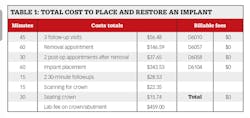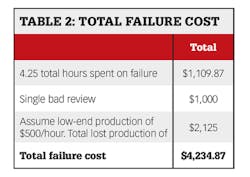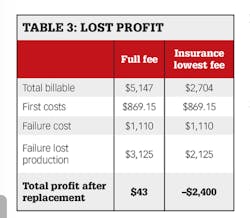The cost of a dental implant failure
Literature indicates that dental implants have a high survival rate.1 However, like any other medical device, dental implants are subject to failure.2 There is currently a plethora of literature that shows surgical techniques and methods of treating or replacing failing and failed dental implants.3 Unfortunately, there is a lack of literature when it comes to the exact cost of a dental implant failure.
Here we’ll analyze the cost of a dental implant failure after it has been restored and is in function at a granular level. We look at a variety of indicators such as fixed cost, overhead, material costs, lost wages, time spent, and negative review potential to generate the approximate cost of a dental implant failure both in a general dental office and a specialist office.
Fixed and material cost of failure
After analyzing both fixed cost and material cost and calculating how much it costs to keep an office running per hour (download Typical implant placement and Failed implant one year after), the total cost to place and restore a dental implant in an average general practice dental office is $1,100 (table 1). In an office using premium materials and laboratory or that has high rent or wages, it can be closer to $2,000. Depending on fee schedule and insurance reimbursement, total billable production for dental implant and dental crown can range from $2,700 to $6,200.
Related articles
What are the main reasons for implant failure?
Dental implant contamination: 3 reasons behind a late-stage failure
Lost wage potential
The average general dentist (single provider) in the United States generates $500 per hour and could be up to $1,500 per hour (single provider specialist). The estimated time it takes to place a single fixture implant, restore it, then explant it when it fails, replace the implant and crown, along with all the follow-up visits, is estimated to be approximately four to five hours (table 2). Lost wages will be calculated to range from $2,000 to $7,500 dollars, depending on the provider.
Cost of a bad review
According to one site, the formula for the cost of a single bad review for a year can be calculated3 as (LC + RC) x CLV X 12 = single bad review. LC = lost customer, RC = referred customer, CLV = customer lifetime value multiplied by 12 months. For a dental practice the numbers are estimated to range from $1,000 to $6,000.
Final calculation
After taking the high and low billable fee, subtracting fixed and material cost, lost wages, and estimating the cost of a single bad review, using the low average of $1,000, the total cost of a single implant failure can range from a breakeven to minus $2,400 in a general dentist office (table 3). In a specialist office, this number ranges from breakeven to minus $3,800.
Editor's note: This article appeared in the November 2022 print edition of Dental Economics magazine. Dentists in North America are eligible for a complimentary print subscription. Sign up here.
References
1. Howe MS, Keys W, Richards D. Long-term (10-year) dental implant survival: A systematic review and sensitivity meta-analysis. J Dent. 2019;84:9-21. 10.1016/j.jdent.2019.03.008
2. Simonis P, Dufour T, Tenenbaum H. Long‐term implant survival and success: a 10–16‐year follow‐up of non‐submerged dental implants. Clin Oral Implants Res. 2010;21(7):772-777. doi:10.1111/j.1600-0501.2010.01912.x
3. Froum S. Replacement dental implants: 3 clinical methods to increase survival rates after initial implant failure. Dental Economics. June 5, 2018. https://www.perioimplantadvisory.com/clinical-tips/article/16412259/replacement-dental-implants-3-clinical-methods-to-increase-survival-rates-after-initial-implant-failure
4. Tyler B. Calculating the cost of a 1-star review. Revenue Jump. May 6, 2021.
About the Author

Scott Froum, DDS
Scott Froum, DDS, a graduate of the State University of New York, Stony Brook School of Dental Medicine (SUNY), is a periodontist in private practice in New York City. He is the editorial director of Perio-Implant Advisory and serves on the Dental Economics advisory board. Dr. Froum is a volunteer professor in the postgraduate periodontal program at SUNY and a PhD candidate in the field of functional and integrative nutrition. Contact him at drscottfroum.com.
Read Dr. Froum's DE Editorial Advisory Board profile here.

Addison Killeen, DDS
Addison Killeen, DDS, is the author of six books, most recently the Dental Marketing Manual. He has a history of owning multiple practices, from startups to acquisitions. He is also a cofounder of the Dental Success Network (DSN). He currently owns and manages Capital Dental, a large group practice in Lincoln, Nebraska.



